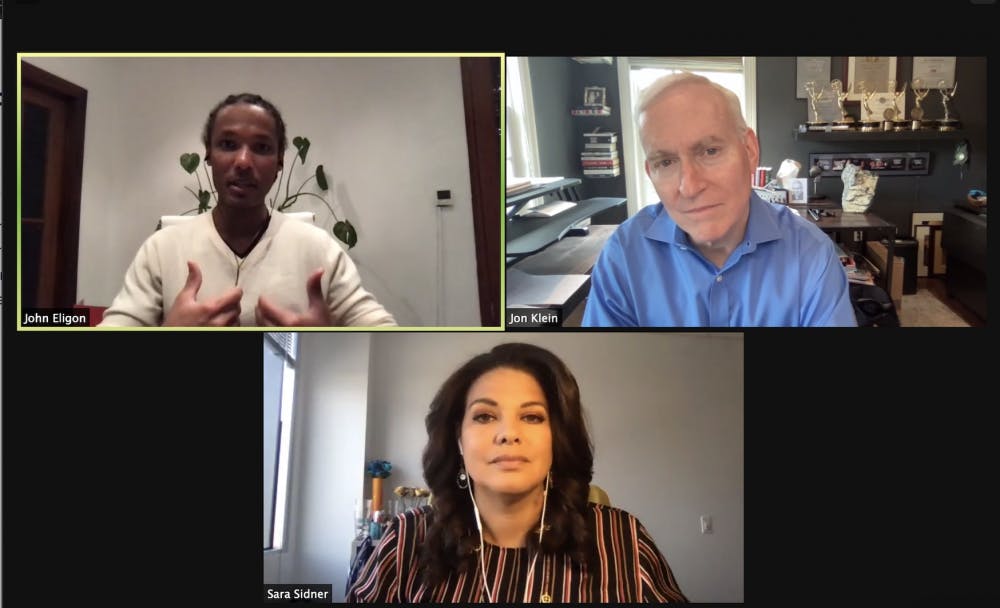Earlier this year in January, CNN correspondent Sara Sidner broke down crying on live television after reporting about COVID-19’s impact on minority communities from California. She had just been with a grieving family forced to have a funeral service in a parking lot while hospitals and funeral homes overflowed, and she found herself overwhelmed by all the emotion she had been holding in.
Sidner began Brown Lecture Board’s Tuesday panel, “From the Streets to the Newsroom: Reporting on Race,” discussing this moment, alongside New York Times National Correspondent John Eligon and moderator Jon Klein ’80, former president of CNN. The event was hosted in collaboration with the Watson Institute of International and Public Affairs.
During the panel, Sidner admitted that while she was embarrassed to have lost her composure in that moment, she found that many viewers felt similarly overwhelmed by the pandemic at the time. In years past, she said, she would not have let the public in on how she felt reporting that piece. But Sidner said she now finds herself more honest with her audience on the emotional impact of her work.
“We’re taught in journalism to keep your personal opinions, your personal emotions, your personal well-being, all those things to the side,” Sidner said. “What I have come to understand over these many years is that I can’t completely separate my emotional involvement with these stories, and I think I need to make that clear to the audience.”
In Tuesday’s conversation, Sidner and Eligon talked with Klein about the emotional impacts of reporting on the pandemic and how the media covers race.
Sidner, who worked for CNN internationally in Jerusalem, Abu Dhabi, New Delhi and Libya, moved to CNN’s Los Angeles desk in 2014. She led the network’s coverage of the protests that followed the murder of George Floyd and the trial of Derek Chauvin as well as protests in Ferguson, Missouri, after the fatal shooting of unarmed Black teenager Michael Brown.
Eligon recently moved to the Times’s Johannesburg desk as the paper’s Johannesburg bureau chief, but previously worked as a national correspondent based in Kansas City covering race for the Times.
Using his Jan. 3 story about a COVID-19 relief fund for Black Oregonians as an example, Eligon discussed the importance of context in a story and the nuances of a reporter’s duty to not only search for the truth, but to tell the truth.
“Sometimes, telling the truth can feel like advocacy,” Eligon said, adding that the current polarized, politicized nature of society can exacerbate that feeling. But ultimately, he continued, it is a reporter’s job to understand the context of both sides of conflict and report honestly on how certain systems disadvantage different people.
Throughout the event, both panelists harkened back to themes of truth and race in the media.
“They gave very deep and thoughtful answers that went far beyond the individual stories that they’ve been working on,” Klein told The Herald in an interview after the lecture. “They’ve really taken a global perspective of it all.”
The event, which included a portion when audience members submitted questions for the panelists, was intended to be conversational with the hope of encompassing a variety of perspectives, according to Jordan Kei-Rahn ’21, co-vice president of logistics for BLB.
“We thought about how we could integrate different journalists and come up with some way where we could have multiple perspectives,” Kei-Rahn said. “That’s never really something the election board has really done before –– we (usually) focus on highlighting one voice and letting them tell their story, but this time we wanted that back-and-forth because there are so many perspectives on journalism.”
BLB has previously hosted conversations with comedian Ali Wong, civil rights attorney Benjamin Crump, comedian Hasan Minhaj and President Joe Biden.
Both journalists offered young reporters advice on how to best navigate the complicated world of news and media toward the end of the event.
When asked how to teach students to cover racial inequity and injustice on campus, Eligon offered an analogy.
“About 18 months ago, who knew what COVID-19 was?” he said. “Now, I’m sure we know all these different things about particles and all this stuff –– and we learned that because we just went out and recorded, we asked questions, we read, we researched, we talked to experts. I would say the same thing applies with race.”
Eligon emphasized that anyone can cover racial issues, and that a journalist does not have to be from a marginalized racial identity to report on race. He advised that it’s important to teach students that reporting about race can and should follow the same principles of any other reporting venture.
“There’s this tendency to want to say that race coverage is more about opinion and feeling,” Eligon said. “But as we said earlier, there are facts, right? Start by reading, start by learning history and start by learning the facts right.”
Conversations about race, Sidner added, will almost never be easy.
“People need to be taught that you’re going to be uncomfortable. Nobody enjoys talking about race,” she said. Feeling uncomfortable and being okay with that, she added, is really hard.
Both reporters wrapped up the panel by addressing how newsrooms can continue working toward better coverage of race.
Sidner believes that ultimately, improvements will come from listening to the reporters on the ground, and the stories they feel are important to tell.
“I do think representation is important in management, but I also want someone who listens, someone who is capable of coming out of their own world and listens to the people in the field,” she said.
After hearing the two journalists speak, Kei-Rahn discussed the implications of organizing the event as a white male. Ultimately, by listening to the speakers, he gained the tools to empathize with people around him and be a more informed consumer of news about race, he said.
“It’s all about educating yourself,” he said. “I’m (by) no means an expert on media and race, so I feel that I have an obligation to make sure I educate myself in a way that’s accurate and a way that allows me to understand the issues that my peers and colleagues are facing throughout the world.”
After the lecture, Klein spoke to The Herald about his own experiences working toward a more diverse newsroom as president of CNN.
One of the initiatives he pointed to was the “In America” unit, which included series like “Black in America” and “Latino in America.” The key to keeping these voices in the mainstream news, Klein said, was staffing these programs with enough people, keeping them on primetime and promoting them as heavily as anything else on primetime.
Klein added that while “newness” is the core of news, issues such as race and climate change are ongoing. The best advice he has for newsrooms, he said, is to keep them staffed with people who are driven to find new angles to familiar conversations.
“They have to have people who understand what’s at stake,” he said, and who understand “what the stories are.”

Gaya Gupta was Senior Editor of Digital News for the 132rd Editorial Board. She previously covered diversity on campus. She is a junior from the San Francisco Bay Area studying computer science and English.





